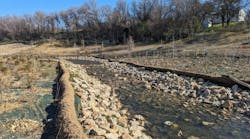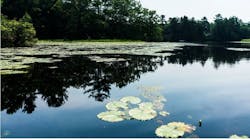Many states have come to the same conclusion North Carolina did several years ago: Conventional sediment basins do not work very well. This is not surprising because the outlets (perforated risers or stone filters) typically do not adequately regulate outflow to ensure that the basin fills; then they drain the basin from the bottom, releasing the muddiest water in the basin. Research has found that these types of basins capture only 50% of the sediment entering them. Releasing water from near the surface—the water with the least sediment in it—would improve sediment-trapping efficiency. The Faircloth Skimmer surface drain for sediment basins does this and regulates the draining so that the initial runoff fills the basin to create conditions that allow gravity settling to occur. Then the skimmer releases the cleanest water in the basin at a uniform rate over several days to maximize settling.
Alabama is one of several states to adopt this sediment basin design to improve performance. A basin built in Alabama to demonstrate efficiency is shown in the photograph. Research at North Carolina State University has shown that with basins that are properly sized and shaped and that utilize porous baffles to slow the flow through the basin and prevent dead zones, trapping efficiencies of 90% to 95% can be achieved. Even with high-trapping efficiency, outflow will still be turbid with clay soils. The Faircloth Skimmer enhances the use of a flocculent on clay particles that will not settle by gravity alone and will pass through the basin. The skimmer will capture the initial runoff with the flocculent in the water and hold it, giving the sediment time to settle and creating a clean layer of water on the surface that is released through the skimmer.
Download: Here





